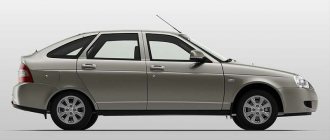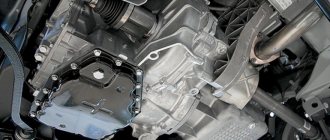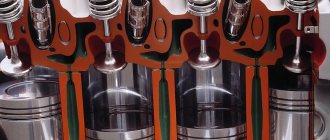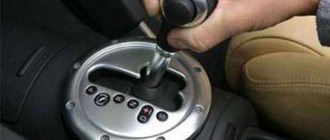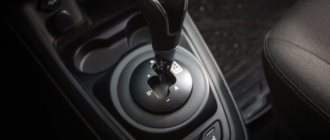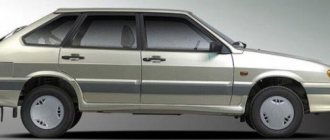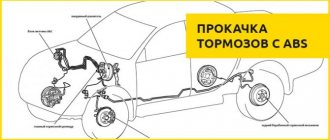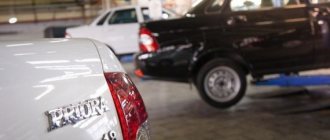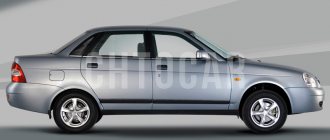How to change gears correctly
In this article I want to give a basic understanding of the essence of the gear shifting process, which will allow you to automatically select the correct gear to drive each time in order to ensure the desired driving mode in a specific situation and get:
If we switch to second at this moment, then the wheels They will also move at a speed of 25 km/h, but the engine will spin at lower speeds, approximately 1800 rpm. The engine will be under heavy load at this moment. This is similar to a long and short lever - the long one is easier to move, but you need to cover a greater distance, while the short one will require more force, but you won't need to deflect it much.
Lada Priora Hatchback — WhiteAnomaLia — › Logbook › Shifting gears, how to and how not to)))
In non-professional circles, and often in professional ones, there are a lot of misconceptions about gear shifting. The purpose of this article is to tell you how to do it correctly. We do not set ourselves the task of covering all aspects and talking about all the intricacies of gear shifting, for example, how and in what cases you can shift without using the clutch. We want to explain the correct basic technique. This will answer almost all your questions and dispel any confusion, allowing you to confidently and correctly change gears both on the track and on the street.
First, we will explain what a gas booster is and why it is needed. Imagine that you are driving 60 km/h... Suddenly a fancy Sky with neon lighting “flies up” to you from the left and starts honking and accelerating. Of course, your action is to move on and I’m not in a hurry. But suppose you decide to answer the “challenge”. You need to shift from 5th gear to 2nd. If you simply depress the clutch, engage 2nd gear and release the clutch, the car will jerk very strongly, and the clutch with the gearbox will have a hard time. Why is this happening?
How to change gears correctly
Now let's discuss the details. Your car has started to move, first gear is engaged, the clutch pedal is fully released, and you are driving at low speed. Smoothly pressing the gas pedal, accelerate the car to approximately 20 km/h, remove your foot from the gas pedal and quickly, but not sharply, press the clutch pedal all the way. Immediately move the gear shift lever to the neutral position for one or two seconds (at this time the gears in the gearbox equalize the rotation speed), and switch to second gear. After changing gear, you need to quickly, smoothly release the clutch pedal and increase pressure on the gas pedal. Thus, you increase the fuel supply and accelerate the car in second gear, the speed becomes about 30-40 km/h.
The procedure for switching to third gear is the same as when switching from first to second, the only difference is that when accelerating you should reach a speed of about 35-40 km/h. Have you mastered driving in third gear? It's time to move on to the fourth, and then to the fifth.
At what speed to change gears P12
The question is stupid but it doesn’t give me peace. Since there has never been a 6-speed gearbox, I don’t know how it would be more correct to change gears, since compared to a 5-speed manual transmission, the speeds are high with a 6-speed manual transmission. Now I switch like this: 0-20-1st 20-40-2nd 40-60-3rd 60-90 (100)-4th (3000 rpm and above) 100-140-5th 140-. -6 I read somewhere on the forum that my engine doesn’t like running at high speeds for long periods of time, and already at 4th gear it flutters at 3000 rpm. It’s just that on previous cars there was 4th gear = 2500 rpm, and only 5th at a speed of 120 = 3000-3100 rpm. Does it make sense to reconsider the speeds or just not worry and score?
6 speed manual transmission, 2.0 140 hp in my opinion, the most juice is on P12 (exactly for IMHO)
.
Regarding gears: as a friend of mine says, my car only needs four gears. On automatic machines
the gearbox often has four stages. On manual transmissions, 5 and 6 are bonuses, since 5 and 6 allow you to save gas on the highway. Personally, at 80 km/h I use 5U, my consumption in the combined cycle is 8.2 liters. I think 6U can be used from 100 km/h to save fuel. If you need to set a record max. speeds need to be turned in each gear almost to the cutoff...)))
How to change gears correctly on a Priora
If when switching to higher gears it is necessary to observe the sequence and not jump, then when switching to lower gears this condition is not necessary, i.e. You can go from fifth gear to third or second, to do this you should reduce the speed to the required limit that corresponds to this gear.
We hold the lever in the neutral position for half a second and turn on the second one smoothly. transmission, release the clutch pedal to the point, hold it and grab it at this point for about half a second. Add gas while simultaneously releasing the clutch pedal to Return. Place your left foot on the platform next to the clutch pedal, and your right hand on the steering wheel.
How to correctly shift from 1st to 2nd gear? (Lada XRAY)
I just can’t get the hang of shifting manual transmission gears from 1st to 2nd without jerking. (Engine 1.8). When switching smoothly at 1800-2021 engine speeds, the car loses speed and begins to twitch during acceleration. If you spin the engine harder (2500-2800 revolutions), then after releasing the clutch pedal the car nods (the effect of engine braking).
This is interesting: In Novosibirsk, there is time for loud music for residents
Lada (“Lada”) is a brand of cars produced by AvtoVAZ JSC. Previously, it was used only for export cars, and for the domestic market, cars were produced under the Zhiguli brand. In 2021, the management of AvtoVAZ announced the transition to the Latin alphabet for the official spelling of the names of all cars produced by the plant: Lada - instead of "VAZ" and "Lada".
How to learn to shift gears correctly
Of course, one of the best options for mastering gear shifting is to turn to experienced and responsive instructors. In addition, the driving school has a high level of classroom equipment, the availability of specialized simulators and all the necessary literature, and the attractiveness of the cost of training simply cannot leave anyone indifferent.
In the technical aspect of driving a car, the ability to correctly shift gears of a manual transmission is the most difficult and most significant moment. Although it is the “mechanics” that allows you to get real pleasure from driving and from deciding exactly how to get started and how intensely to accelerate, and the level of extreme driving requires the ability to
change speeds correctly.
Gear shift
This position applies when driving under normal conditions.
The car starts off in first gear and then automatically shifts between 2nd, 3rd and 4th gears. The switching moment depends on the position of the accelerator pedal and the driving speed. This position is recommended when driving on mountain roads. This makes better use of engine power and increases the engine braking effect. The transmission automatically shifts between first and second gears. Third and fourth gears are locked.
How to change gears
The figures given in the table are different for different machines. For example, for VAZ 10 family cars you need to add 10 km to each speed (in 2nd gear you can accelerate to 90 km/h). You can determine the upper limits for your vehicle using a tachometer. As a rule, the upper limit is 5.5 thousand revolutions (for normal driving it is better to switch to 3 thousand).
4. At the crossroads. For example, the light is green ahead and there are no cars, fourth gear is engaged and the speed is 60 km. When there are 70 meters left to the intersection, you can shift into third gear and complete the maneuver with the permission signal, even if at that moment the traffic light starts flashing.
Operating principle and troubleshooting of the VAZ 2110 gear shift mechanism
A separate important gearbox component is the gear selection mechanism. It has a special speed selection lever, as well as two locking brackets. One arm of the selector lever turns on the forward stroke, the second serves to turn on the rear.
If the described adjustment did not help you, you need to remove and disassemble the VAZ 2110 gearbox. Pay special attention to the fact that the gears with which the first and second speeds are engaged often knock out. Be sure to check each fastener.
We recommend reading: How to work with the created reserve for doubtful debts in 2021
How to accelerate correctly in a Priora
Otherwise, acceleration will be sluggish. To choose the right moment, there is a MCM value. Normal operating acceleration occurs when the driver engages the next gear when the engine reaches maximum torque. In relation to the Lada Priora, which we took as an example at the beginning of the article, this means that the tachometer needle will be at around 35,004,000 rpm. It is possible, of course, less, but below the 3000 rpm mark.
The optimal speed for shifting up gears (from first to last) is the speed corresponding to the engine MCM. But, for example, in a situation where acceleration is carried out downhill or on a descent, you can start switching earlier, at approximately the 28003000 rpm mark. If acceleration is done on a climb, it is better, on the contrary, to switch later, somewhere at 4000-4500 rpm.
How to adjust gear shifting on a Priora
Reasoning from a car owner named Eberhard: Excellent engine and handling, the car is responsive and maneuverable. Large trunk. The dynamics are very excellent for such money. The behavior of the car in winter is just right for our country. Very warm. In winter, when I get behind the wheel, I take off my jacket, because it’s hot, even on the heat setting. Ha 92 petrol walks great
Description: The dimensions are as follows: length - 3535, width - 1100, height - 1411 mm. The wheelbase is 2907 mm. Ground clearance 125 mm. The car is equipped with a hybrid power unit. The 2-cylinder engine is equipped with a system that provides engine power output. There are 4 valves per cylinder. The diameter of one cylinder is 73 mm, the piston stroke is 78 mm. The engine crankshaft accelerates to 6000 rpm. Maximum torque is maintained up to 2021 rpm.
How to Engage Reverse Gear on a Priora
The input shaft 29 is made in the form of a block of drive gears, which are in constant mesh with the driven gears of all frontal gears. The secondary shaft 25 is hollow, with a removable drive gear 3 of the main gear. On the secondary shaft there are driven gears 16, 18, 19, 21, 23 and synchronizers 17, 20, 24 for front speed gears. Front bearings 4, 31 shafts are roller, rear bearings 22, 28 are ball. An oil sump 5 is located under the front bearing of the secondary shaft of the Lada Priora, directing the flow of oil inside the secondary shaft and further under the driven gears.
The differential is symmetrical with 8 gears and 2 10 conical satellites. The preload in the Prior differential bearings is adjusted by selecting the thickness of the ring 13. The driven gear 12 of the VAZ 2172 main gear is attached to the differential box flange.
How to change gears correctly on a manual transmission
The faster the speed increases, the more actively you need to shift to higher gears. When you achieve perfection in this technique and achieve a smooth ride, the moment of changing gears will become completely invisible to your passengers.
The main difficulty for novice drivers is achieving automaticity and synchronization when changing gears and pressing the clutch pedal . Even the quickest glance at the box or at your feet can provoke an emergency.
Troubleshooting the Priora gearbox and the algorithm for dismantling the unit
- gears are difficult to engage;
- Spontaneous gear shifting (gears are thrown out)
- gears do not engage or are engaged with great difficulty and extraneous sounds, the car jerks while driving;
- The gearbox is noisy, when you press the clutch pedal the noise disappears;
- extraneous sounds when shifting gears - grinding, crunching, squealing, rattling, creaking, vibration;
- oil leak.
When carrying out diagnostics, it should be taken into account that the same symptom may indicate several malfunctions at the same time. Determining the exact cause is carried out only after removing and disassembling the gearbox. Carrying out repair work and identifying worn or damaged parts requires qualifications and experience.
The first gear does not engage well on the Priora: reasons and solutions
- Drain the gearbox oil. Drive the car onto a flat surface, into a garage with a pit or onto an overpass. Climb under its bottom and find a plug for draining the working fluid; place a container under the hole into which the “working off” will be drained. Unscrew the bolt with a wrench and wait about one hour until the fluid is completely out of the system. After this, the transmission is dismantled.
- The next step is performed in the salon. Under the control panel there is a fastening nut of the cable housing; it is connected directly to the pedal. Unscrew the nut with a size 8 wrench. After unscrewing, you can remove the stop from the bracket.
- Remove the locking assembly, as well as the housing of the driven pulley lining wear compensation mechanism; these components are connected to the so-called pedal pin. To dismantle, use a screwdriver with a Phillips head; the tool must be used to pry off the mechanism. Remove the plastic bushing from the pedal and inspect it carefully. The presence of damage and defects indicates the need to replace the part.
- Then the seal on the cable sheath is removed; this component is located in the engine compartment. Remove the tip from the fork by moving it forward in advance as the machine moves.
- Unscrew the nut that secures the tip to the bracket in the gearbox. This nut will require a 17mm wrench. Remove the cable end from the fastening hole. After this it can be removed. Remove the plastic plug and remove the plug with wires from the speed controller.
- Unscrew the three screws securing the crankcase cover; this will require a 10mm wrench. The cover is removed. A reliable support should be placed under the power unit of the machine. Unscrew the nut that secures the rear of the engine mount to the bracket; this will require a 15mm wrench.
- Remove the upper limiter of the rear engine mount cushion. Unscrew the screws that secure this element to the car body. Remove the cushion along with the restraint device.
- Unscrew the nuts securing the rear motor mount to the transmission. To unscrew, you will need a 13mm wrench. The number of nuts depends on the year of manufacture of the car. Using a size 8 wrench, unscrew the upper fixing screw, and then remove the rear support bracket.
- Remove the plastic plug and remove the block with wiring from the reverse optics activation mechanism. Unscrew the screw that secures the gear shift device hinge on the rod; this is where the speed selection takes place. To dismantle, use a 10mm wrench.
- Unscrew the screws securing the torque rod. Also unscrew the bolts that hold the front wheel hubcaps and remove them using a flat-head screwdriver. There are rubberized seals on the removed parts; be careful not to lose them.
- Using a 30mm wrench, remove the wheel retaining screws and wheel nuts. When performing this task, the vehicle must be on the ground and not on an overpass or lift. Secure the vehicle in place by lifting the parking brake lever. Support the rear wheels.
- Using a jack, lift the front of the car and remove the wheels. Then completely unscrew the hub nuts and remove the washers installed under them. Dismantled parts (we are talking about nuts) must be replaced. Disconnect and remove the rotating devices from the suspension arms, before doing this you should unscrew the mounting screws, use a 17 key. Remove both drives by pressing them out of their seats. Place a support under the gearbox to avoid damaging the unit.
- Unscrew the screws securing the transmission to the motor; this will require a 19mm wrench. Then move the unit as far as possible. The gearbox removal procedure is complete. Assembly is carried out in reverse order.
- The car is driven into a garage with a pit or onto an overpass.
- Unscrew the screws securing the power unit mudguard, and then remove it.
- Locate the drain hole on the transmission under the bottom of the car. Place a container under it in which you will collect the used oil. Use a wrench to unscrew the plug and wait until the fluid comes out of the transmission. After dismantling, the drain cover must be cleaned; all wear products and traces of dirt must be removed from it.
- Assess the quality of the drained oil. If it is too dirty, then it is advisable to wash the transmission unit. First, about 1.3 liters of flushing agent is poured into the box crankcase, and the filler neck is closed. After this, the front wheels of the car are hung on a jack, and the engine is started. The engine should run at low speeds, and the first speed should be turned on. Repeat the procedure for draining the flushing agent. If necessary, clean again.
- Remove the dipstick from the inspection hole. The procedure for adding fresh fluid is carried out using a syringe with a connected hose. Enough lubricant is poured into the gearbox housing so that its level is in the area of the MAX mark on the meter. This will require about 3.1 liters of liquid. Then the probe is installed in the technological hole to the end.
- Reinstall the engine splash guard. Perform a test drive on the car, wait until the transmission cools down, and then check the lubricant level again.
Causes and solution to the problem of unstable engagement of first gear on Priora
It’s worth noting right away that there is no way to determine a faulty gearbox shaft or bearings at home. Only a competent technician at a service station with expensive specialized equipment will help you do this. Therefore, if you encounter problems shifting the gearshift lever, then you can only hope that the problem lies in the adjustment.
- First, dismantle the car floor tunnel lining.
- Using a “13” wrench, unscrew the fastening nut of the gearbox lever axle.
- Remove the lever axle stop mounting screw.
- Now you need to move the lever itself to the side and remove its axis along with the stop.
- You will see two plastic and one spacer bushings.
- If the fault lies precisely in them, then install new bushings. Remember: the plastic parts themselves are split, so don't assume they're cracked.
- Now install all the components in the reverse order, lubricating them with Lithol in advance.
How to change gears correctly on a Priora
1. Release the gas pedal. 2. Gently press the brake 3. When the car speed reaches the desired limit for a lower gear (if you were in fifth, then to switch to fourth speed it should be 70-90 km/h), press the clutch. 4. Without holding the lever in the neutral position, switch it to the desired gear. 5. Smoothly release the clutch. 6. Gently press on the gas to maintain speed. If further braking is necessary, do everything in the same sequence. The peculiarity of shifting gears in the reverse order is that from any higher gear you can immediately go to any lower one. For example, from fifth to third or second. To do this, you need to reduce the speed of the car to the indicators of one or another gear.
At idle, the engine produces 600-800 rpm. To start moving, the engine only needs to reach 1600 rpm. So at what speed should you shift gears? When the speed reaches 2500 to 3500 rpm, it does not matter what gear the car is currently moving in.
The fourth part of the Driving section contains a very important topic. To roll and not slide (for example), you need to start correctly. Now let's look at how to accelerate correctly. But first, let’s figure out what is responsible for acceleration dynamics in a car. Any car engine has two important characteristics: maximum torque (MTM) and maximum power (MP). For example, for a VAZ-21126 car (Lada Priora) with an engine capacity of 1.6 liters, MKM 145 Nm at 4000 rpm.
, MM 98 l. C. At 5600 rpm. It is easy to notice that next to these characteristics is the value of the crankshaft revolutions. In other words, maximum engine torque and maximum power are achieved only at a certain engine speed. There is no need to go deep into the analysis of engine operation, you just need to remember that in MM (maximum power) mode the engine develops maximum speed, and in MKM (maximum torque) mode maximum acceleration.
We are interested in precisely this acceleration, because the engine thrust, and, consequently, the acceleration intensity, depends on the torque. So, we found out that the engine torque is responsible for the acceleration dynamics of the car, which we can regulate by pressing the gas pedal and changing gears. The higher the gear, the lower the crankshaft speed at the same speed.
But what about the moment of gear shifting? On cars with automatic transmission, switching occurs automatically. The smart machine itself knows when to switch. In a car with a manual transmission, the driver must be sure that after changing gear the engine will have good traction.
Otherwise, acceleration will be sluggish. To choose the right moment, there is a MCM value. Normal operating acceleration occurs when the driver engages the next gear when the engine reaches maximum torque. In relation to the Lada Priora, which we took as an example at the beginning of the article, this means that the tachometer needle will be at around 35,004,000 rpm. It is possible, of course, less, but below the 3000 rpm mark.
You should not lower the arrow, because after changing gear the engine will pull weakly and will not have enough torque for the subsequent jerk. And if you need the most intense acceleration, for example when overtaking, then you can safely raise the engine speed to MM. Now let’s imagine how we will accelerate in a car with a manual transmission. We set off and are moving in first gear.
We begin to smoothly accelerate the car, for which we press the gas pedal. At the same time, we look ahead at the road, periodically glancing at the tachometer. When the tachometer needle reaches 3000 rpm, place your left foot on the clutch pedal and your right hand on the gear lever. Depress the clutch and at the same time engage neutral gear.
We hold the lever in neutral for half a second and engage second gear. Smoothly release the clutch pedal to the engagement point and hold it at this point for about half a second. Add gas while simultaneously releasing the clutch pedal all the way. Return your left foot to the platform next to the clutch pedal, and your right hand to the steering wheel.
For further overclocking, you will need to repeat steps 1-6. To stop without changing gears, smoothly press the brake pedal and reduce speed. When the tachometer needle drops almost to idle speed (1000-1200 rpm), depress the clutch pedal so that the engine does not stall, and continue to brake until it comes to a complete stop. Now a short comment on these actions.
The optimal speed for shifting up gears (from first to last) is the speed corresponding to the engine MCM. But, for example, in a situation where acceleration is carried out downhill or on a descent, you can start switching earlier, at approximately the 28003000 rpm mark. If acceleration is done on a climb, it is better, on the contrary, to switch later, somewhere at 4000-4500 rpm.
After each gear shift, you need to return your right hand to the steering wheel and your left foot to the platform next to the clutch pedal. When you remove your right hand from the steering wheel to change gear, you need to squeeze the steering wheel with your left hand at this moment more tightly so that the car does not accidentally swerve. What mistakes do drivers make while driving when accelerating? The most common mistake is suddenly releasing the clutch pedal. That is, the driver releases the pedal.
What could this lead to? The main task during acceleration and gear shifting is to achieve a smooth ride. The car should not jerk either at the start or while driving. Leaving the clutch pedal will certainly lead to the wheels slipping and then skidding. Therefore, the pedal must be released smoothly and with a short delay at the moment of grasping. A mistake made by novice drivers is that their left foot rests on the clutch pedal during acceleration. You need to get used to putting your foot on the platform, we have already discussed how.
Another mistake that beginners make is that they look for the gearshift lever with their eyes or look at it while shifting. In this case, control of the road is lost. In order to avoid making such mistakes while driving, you should work through all the actions while the car is standing still, and when your arms and legs remember their position, you can drive to the site. We will return to the topic of driving safety in the section, but for now it is necessary to understand the basic principles of driving a car. So, we have defined the concept of overclocking and found out how it should be done correctly.
How to change speeds on a VAZ 2110
To engage reverse gear, press the clutch pedal and, after holding for 3 seconds, press the gear shift lever all the way and move it to the reverse gear position. Everyone must learn to move a car away smoothly in compliance with a certain sequence, safety requirements and traffic rules. A little theory. When moving, a car overcomes a number of forces that create resistance to its movement.
When moving the lever from position “D” or from position 3 to position 2, switching from third to second gear occurs only at a speed lower than a certain predetermined speed, in order to avoid increasing engine speed to unacceptable values.


